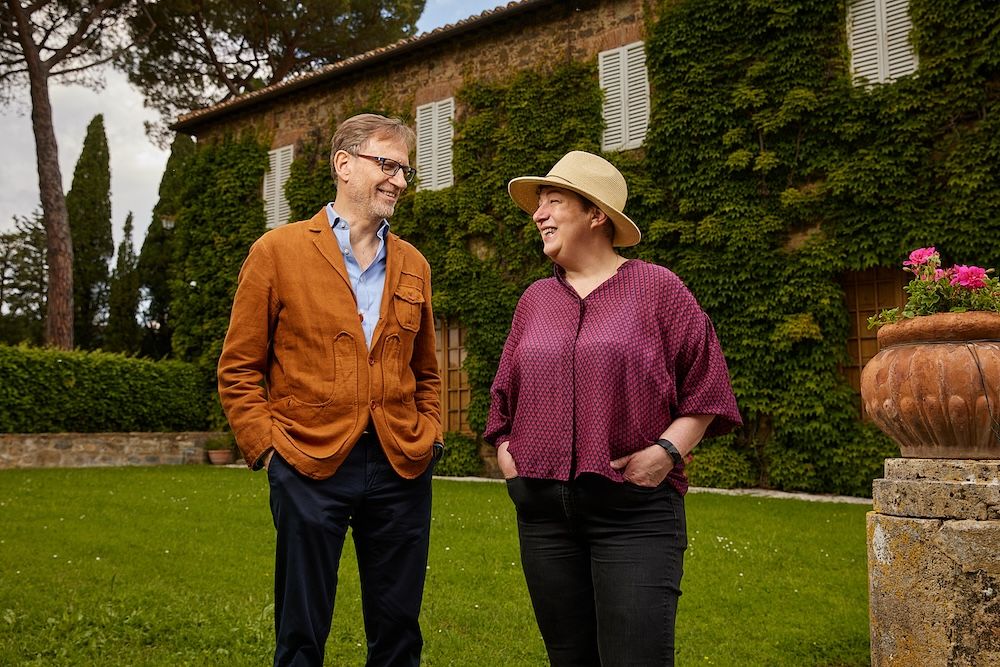It seems an unlikely pairing to have a brand ambassador whose first exposure to wine was potato and pea pod wines made in Barnsley “where there are no grapes” with Biondi-Santi, the granddaddy of Brunello di Montalcino, where there most definitely are grapes, and which is one of the world’s most iconic and revered wine estates. But that’s the reality behind an inspired coming-together of talents.
Joanne Harris, Chocolat’s Anglo-French author, was invited by Biondi-Santi CEO Giampiero Bertolini to Tuscany for two days to get under the skin of the estate, and to write something based on the theme of Respect.
Harris duly obliged and, being someone to whom words come easily (or was she on ‘wordage’?!), wrote a lot more than was commissioned – a novella in fact, called The Crown which can be downloaded as text or ingeniously as an audio file, accessed from a QR code on the bottle. This is the third in a series of stories called La Voce which, over time, is intended to build up into a library that “tells the tale of the estate and its evolution over time.”
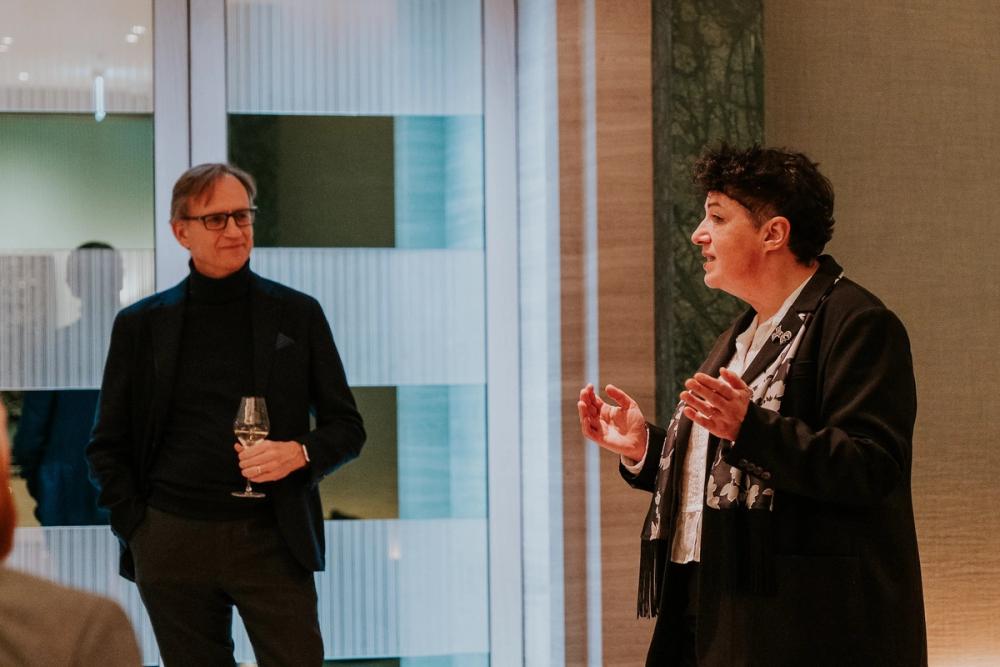
Giampiero Bertolini and Joanne Harris discuss the La Voce project, London, March 2024
La Voce is clearly an ambitious project and an innovative one, veering away as it does from the tradition of commissioning a well know artist to design the new vintage label, as many top wine estates from Mouton to Ornellaia have done. To get an international, best-selling author to write a book about you – that’s impressive and speaks volumes (sorry!) of the innovation, dedication and financial investment that Bertolini and his team have levelled at really getting under the skin of what makes Biondi-Santi great, andto also for them better understand what they bought from the family seven years ago.
It was the wine estate’s agency, Itaca that coordinated La Voce and chose Harris, not for any subliminal marketing reasons – tapping into a particular demographic, say – but more for her skill as a novelist and ability to connect with the world of wine. The project kicked off in 2022 with Elena Dallorso’s short story called ‘Bunches of Notes’ that was based around the theme of Equilibrium; last year Gianni Farinetti wrote ‘Vintage Enigma’ a thriller set in Paris that features a very special bottle of Biondi-Santi Riserva – with this piece being based around the theme of Wonderment.
So what did Joanne Harris make of it all?
“I learnt a lot about soil, about varietals and about how every bottle is slightly different, with every bottle having a narrative of its own,” she says, adding that she tapped into how people really live for the place and their traditions “but also have anxiety for the future.”
It is this caution directed at the effect of changing weather patterns that is now driving many of the changes at Biondi-Santi.
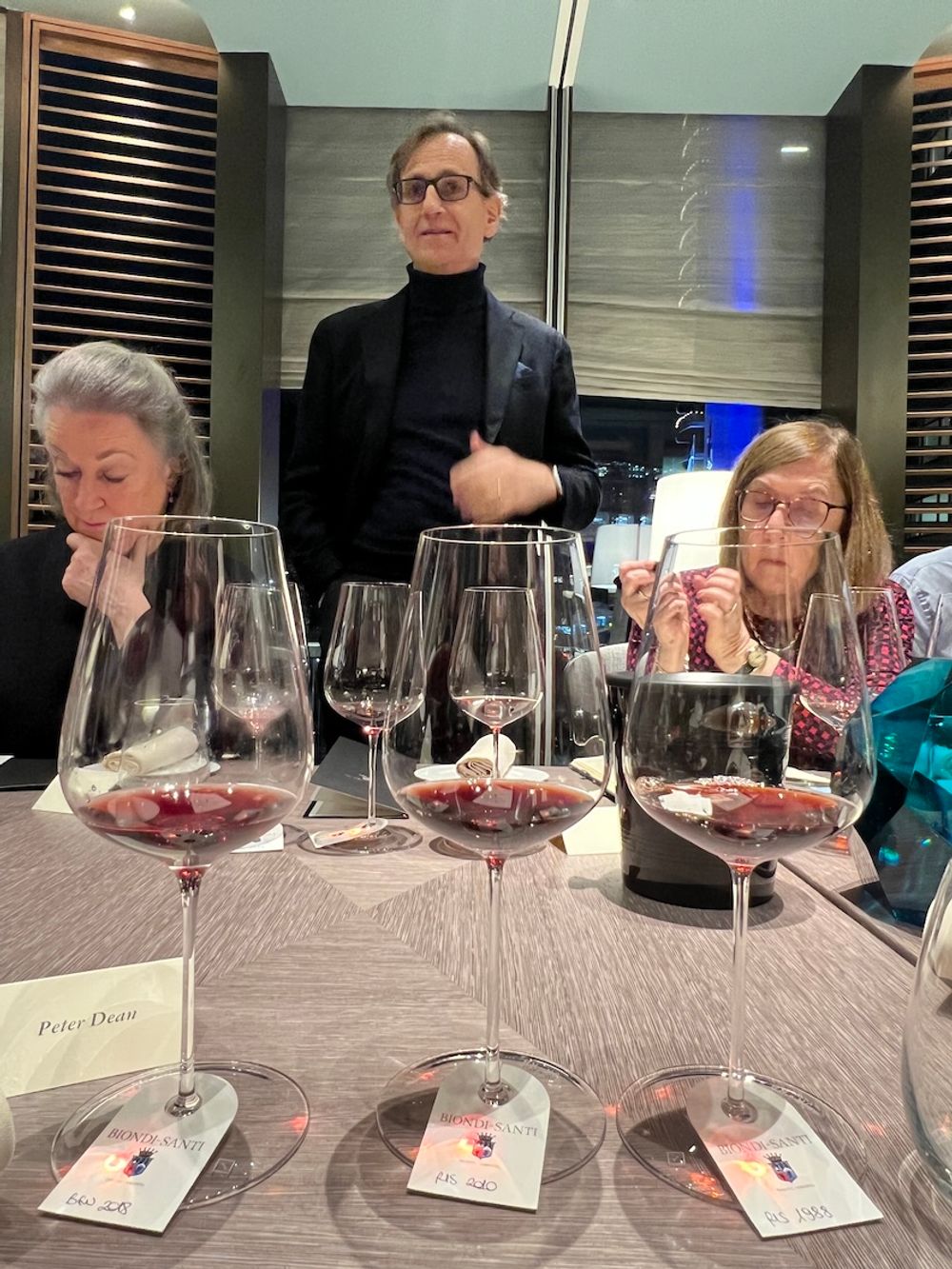
Keeping a keen eye on the future: Giampiero Bertolini at the new vintage launch
Actively preparing for the future
Giampiero Bertolini believes that Biondi-Santi’s wines are best in cooler vintages like the new 2018 wine (the estate is like DRC in that it keeps their top wine back one year longer than others) which partly explains the level of investment into a whole programme of viticultural methods aimed at standing up to the effects of climate change. Most of the estate’s vineyards have a North-East orientation which is partly responsible for the wines’ elegance and firm acidity. However, there is no resting on laurels, the 2022 vintage had fruit picked on August 31 when traditionally harvest comes in late September/ early October.
Advocating an evolutionary approach rather than a revolutionary one, Bertolini says that Biondi-Santi has been actively preparing for the future since Christopher Descours bought the estate in 2017.
In 2019, a year after Bertolini joined from Frescobaldi, Chilean oenologist Pedro Parra was commissioned to conduct a soil study of 32 of the estate’s vineyards identifying 12 different soil types and 12 distinct parcels in the process which now drives the fruit selection rather than what used to be the case of: “oldest vines in the Riserva, youngest in the Rosso and a mix of the rest in the Brunello.” Since 2019, fruit from each of these parcels has been harvested, vinified and aged separately so that the team gets a better understanding of the character of each lot, aiding the fine-tuning of the three main wines.
There is even more ‘appliance of science’ in play. Biondi-Santi is employing an innovative trellising system when it replants vineyards. A lyre-like pole with moveable horizontal bars allows the canopy to grow in a V-shape which creates an umbrella through which the wind can travel and cool the fruit. Mulch and straw also helps keep the soil cool and is a key component of regenerative agriculture which is practised throughout the estate.
Bertolini is keen to stress that he and his technical director Federico Radi are keeping their eye on the future with one foot in the traditions of the past and, in particular, many of the stylistic traits established by the previous family owners. Franco Biondi Santi, for example, worked with the University of Florence in identifying 50 different Sangiovese clones on the estate, including the estate’s native clone named BBS11. 20 of these have been selected as ‘mother vines’ and preserved for grafting a new massal selection – a way of safeguarding the estate style but also as a way of hedging bets against whatever nature is going to throw at them.
As for the Biondi-Santi wine style, this is to consistently make fresh, elegant wines of magnificent finesse, which relies on a solid backbone of acidity, refined tannins, moderate alcohol and firm structure. Bertolini points to a landmark tasting of 100 vintages of Biondi-Santi from 1888-1988 where the 1891 vintage scored 100 points, a recognition of the wines’ ability to age gracefully, which not only helped the estate’s standing but also towards recognition of the entire appellation at a time when the wines were still going under the radar.
Tasting the 1988 today, quite apart from the countless things that were right about the wine, what stood out was the fact that there was absolutely nothing wrong with it which is almost universally the case with tasting a 1988 wine from any other wine region.

So what of the wines themselves?
In normal years Biondi-Santi releases the new Brunello di Montalcino alongside a Riserva from the previous vintage which, would have been the case this year if they had produced a Riserva in 2017. In that wine’s absence it is releasing two back vintages from library stocks, which are the most substantial of any estate in the region, the 2010 and the 1988, both stupendous vintages.
Biondi-Santi Brunello di Montalcino 2018
Alongside the new Rosso, this is ‘the wine of the hour’, released in the UK in the second week of March. From a cool, rain-strewn vintage where the fruit was saved in the eleventh hour before harvest, this is 100% Sangiovese from a selection of parcels, vinified in a variety of formats and materials (steel, concrete, wood) and aged in medium and large Slovenian oak barrels.
Although a youthful wine with aromas needing a little coaxing out of the glass, this is a pretty, precise wine with considerable elegance and finesse. See-through ruby, you pick up violet notes, wild cherries, orange zest; in the mouth the wine is sleek, polished with velvety, ripe tannins, succulent fruit, amazingly approachable with a touch of blue plum skin on the finish which shows its age or lack of. Very smart winemaking.
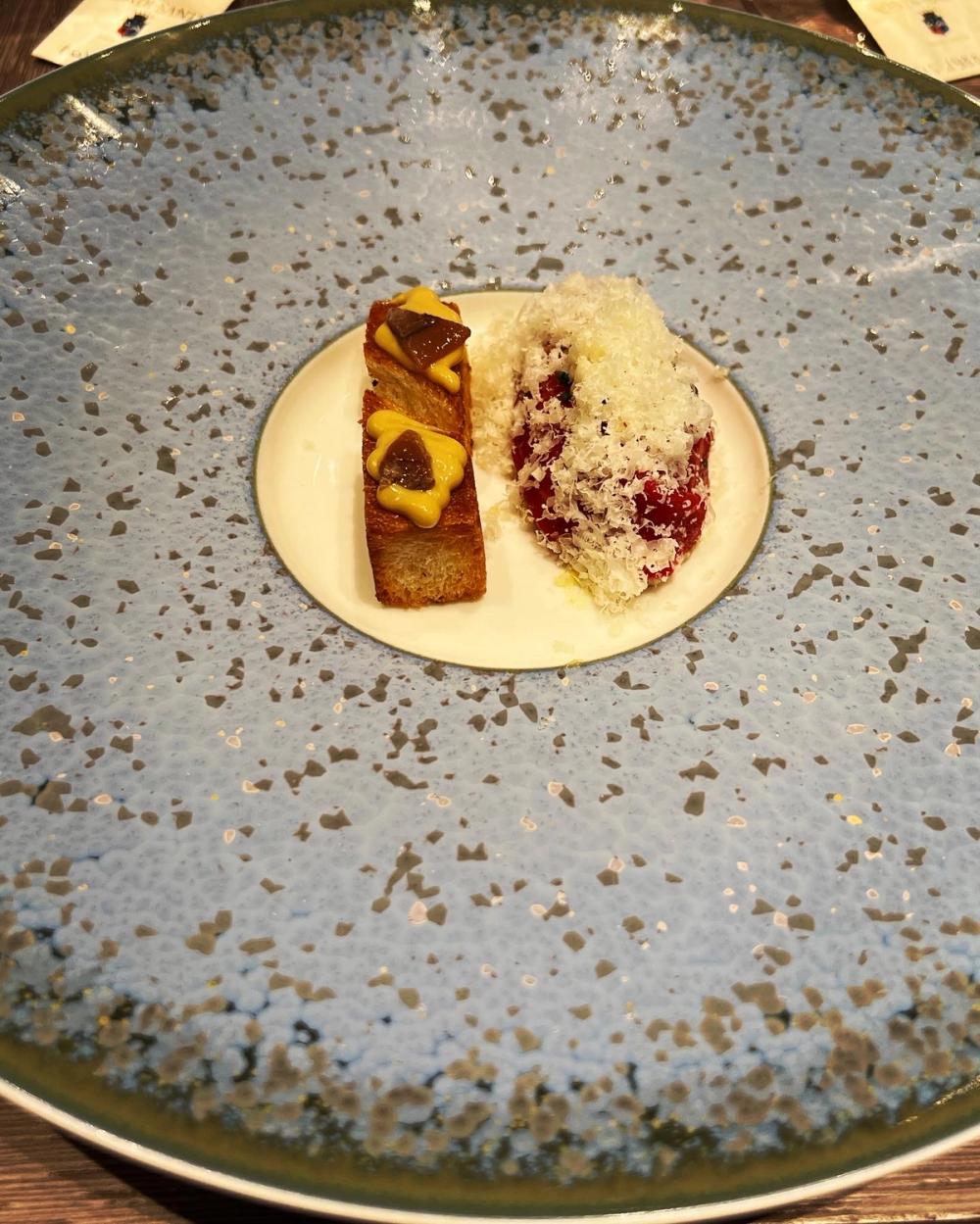
Sensational pairings at the Pavyllon Four Seasons on Park Lane
Biondi-Santi Brunello di Montalcino Riserva 2010 ‘La Storica’
Riservas used to be made with the oldest vines on the estate (no longer the case) but was here. 2010 is an exceptional vintage in Montalcino, of course, as it was pretty much everywhere in Europe. The Riserva was aged in Slovenian oak barrels for three years and has spent the intervening years in the bottle library at the estate.
Even with 14 years on the clock this is still youthful and only just entering its drinking window, a powerful, structured wine that still manages to be elegant and finely judged. The aromas have some forest floor, oak moss and dried flowers, cherries and orange peel; in the mouth the wine is concentrated with firm, powder fine, ripe tannins, austere but with a delicious, rich balance right at the core that marries the acidity, fruit and tannin to perfection and augurs well for decades of ageing. Many pretenders to the throne bandy about the word ‘iconic wine’ but this is the real deal.
Biondi-Santi Brunello di Montalcino Riserva 1988 ‘La Storica’
Cool dry harvest – rainy spring, warm, dry summer – what’s not to like? Like the 2010 this Riserva was aged in Slovenian oak barrels for three years and has spent the intervening years in the bottle library at the estate.
You will find yourself having to check the date on the bottle such immaculate condition this wine is in – as mentioned previously there is no discernible fault, even given the age and its secondary notes. A beautiful see-through rusty orange, the nose is broody with darker undertones than the two previous wines but, excepting a hint of mushroom, it isn’t even exhibiting tertiary notes yet. There is still plenty of fruit – on the nose you find dried blood orange peel, a minty almost eucalyptus note, wood, leather; the palate is sleek, precise with firm, ripe, refined tannins – now fully integrated but not shying away. There is so much life here – ethereal in the proper sense of the word.
Biondi-Santi Rosso di Montalcino 2020
This early drinking wine was called ‘White label Brunello’ until 1983 when the Rosso di Montalcino DOC was created. It is an important wine, Giampiero explained, as it is a gateway into the estate and, presumably, one which is more affordable to more wine lovers.
Apart from a late Spring snowfall and a very hot and dry summer, the growing season was favourable with a good diurnal range and a late August rainfall ensuring good balance and aromatic profile in the grapes. With just a year in Slavonian oak, this is fresh and fruity, aromas of red cherries and plums arising out of the glass, rose petals and dried herbs. Lively, fine-boned tannins, blue plum skin crunch on the finish, touch of blood orange. Delicious youthful Rosso at its best.
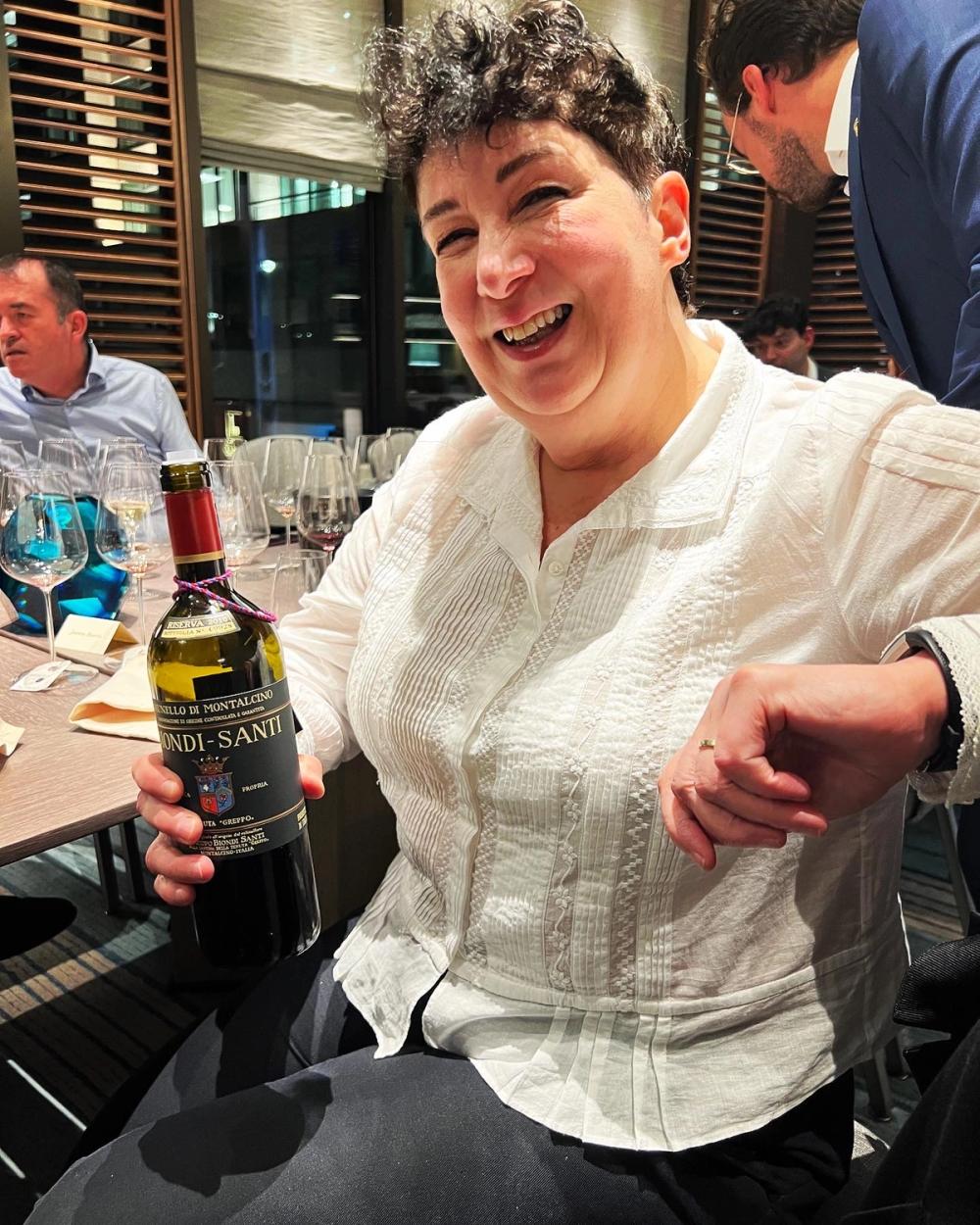
Such an honour to be sat next to Joanne Harris for the evening - an author with a surprising range of interests from graphic novels to hit TV shows like Better Call Saul
